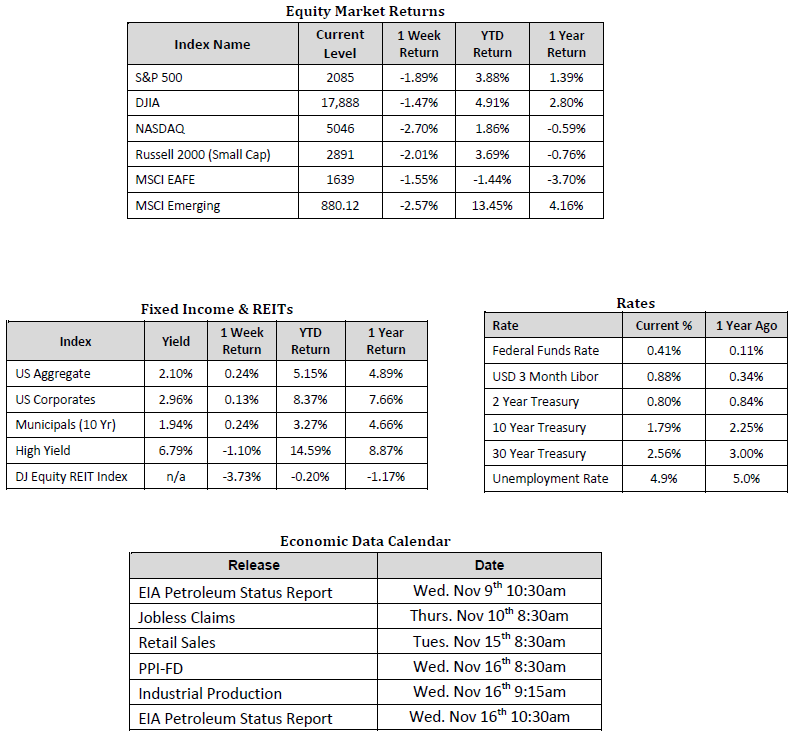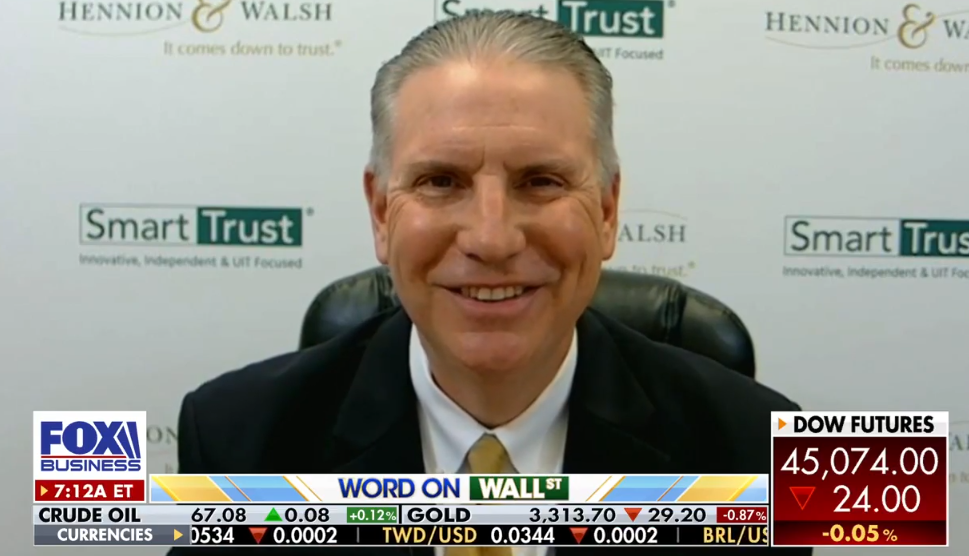
Solid Earnings and Economic Data Forgotten Amidst Political and Monetary Uncertainty
Market Overview
Sources: Equity Market and Fixed Income returns are from JP Morgan as of 10/28/16. REIT, Rates and Economic Calendar Data from Bloomberg as of 10/31/16. Earnings statistics are taken from FactSet as of 10/28/16.
Happening Now
Large Cap U.S. Stocks1 fell 0.7% while Small Cap U.S. Stocks2 fell 2.5% as risk off sentiment rippled through the markets last week. In addition to stocks feeling pressure, bonds offered no shelter as yields rose in anticipation of an upcoming interest rate hike and better than expected economic activity raised the prospect for a faster pace of monetary tightening. Internationally, developed markets3 moved 0.4% lower out pacing emerging markets4 which experienced a 0.8% drop in value. Gold offered some hedge against falling prices, increasing 0.7% for the week.
Despite the broad sell off in stocks, earnings and economic activity data have been strong. In fact, earnings for S&P 500 companies are now expected to post a gain of 1.6% for the third quarter which would mark the first year over year gain in quarterly earnings since the first quarter of 2015. This is in stark contrast to the gloomier outlook analysts forecasted on September 30, when a 2.2% decline in earnings was expected. Also encouraging was the breadth of earnings strength; all eleven sectors are positing higher growth rates today than at the end of the third quarter.
The first estimate of quarter three GDP was issued Friday and showed that the U.S. economy grew at an annualized pace of 2.9%, the highest rate in two years. Prior to this release, a report on U.S. manufacturing showed the strongest move higher in 12 months. Finally, the real estate market appears to be reaching new highs as sales of new single family homes rose 3.1% in September.
All of this positive news that suggests the economy is running stronger has been offset by heightened political uncertainty heading in the final week of the U.S. presidential election. Reports that the FBI is re-opening their Clinton email case has caused some to reassess the probability of her victory which was thought to be baked into the market as a certainty. Politics aside, the recent signals of strength in the U.S. economy suggest that the pace of future Fed interest rate hikes may be higher than most are currently expecting. This has caused bond prices to decline from near record highs and yields to rise. International monetary policy is also in question, with the European Central Bank and Bank of Japan’s current Quantitative Easing/ Negative Interest Rate policies being met with increasing opposition.
The environment we find ourselves in today is very much in line with our expectations for short term uncertainty amid a backdrop of a strong economic environment. We expect that stocks will trade in a wide range with single digit returns over the course of the next twelve months but caution that intermittent periods of falling prices are likely. For these reasons it is imperative that investors take a disciplined approach in order to not fall victim to their own overconfidence in being able to predict market tops and bottoms. Timing the market is often an exercise in futility and unnecessary to achieve long term goals.
1Large Cap U.S. Stocks represented by the S&P 500 Index. 2Small Cap U.S. Stocks are represented by the Russell 2000 Index. 3International developed markets are represented by the MSCI EAFE Index. 4Emerging markets represented by the MSCI EM Index.
Important Information and Disclaimers
Disclosures: Hennion & Walsh is the sponsor of SmartTrust® Unit Investment Trusts (UITs). For more information on SmartTrust® UITs, please visit www.smarttrustuit.com. The overview above is for informational purposes and is not an offer to sell or a solicitation of an offer to buy any SmartTrust® UITs. Investors should consider the Trust’s investment objective, risks, charges and expenses carefully before investing. The prospectus contains this and other information relevant to an investment in the Trust and investors should read the prospectus carefully before they invest.
Investing in foreign securities presents certain risks not associated with domestic investments, such as currency fluctuation, political and economic instability, and different accounting standards. This may result in greater share price volatility. These risks are heightened in emerging markets.
There are special risks associated with an investment in real estate, including credit risk, interest rate fluctuations and the impact of varied economic conditions. Distributions from REIT investments are taxed at the owner’s tax bracket.
The prices of small company and mid cap stocks are generally more volatile than large company stocks. They often involve higher risks because smaller companies may lack the management expertise, financial resources, product diversification and competitive strengths to endure adverse economic conditions.
Investing in commodities is not suitable for all investors. Exposure to the commodities markets may subject an investment to greater share price volatility than an investment in traditional equity or debt securities. Investments in commodities may be affected by changes in overall market movements, commodity index volatility, changes in interest rates or factors affecting a particular industry or commodity.
Products that invest in commodities may employ more complex strategies which may expose investors to additional risks.
Investing in fixed income securities involves certain risks such as market risk if sold prior to maturity and credit risk especially if investing in high yield bonds, which have lower ratings and are subject to greater volatility. All fixed income investments may be worth less than original cost upon redemption or maturity. Bond Prices fluctuate inversely to changes in interest rates. Therefore, a general rise in interest rates can result in the decline of the value of your investment.
Definitions
MSCI- EAFE: The Morgan Stanley Capital International Europe, Australasia and Far East Index, a free float-adjusted market capitalization index that is designed to measure developed-market equity performance, excluding the United States and Canada.
MSCI-Emerging Markets: The Morgan Stanley Capital International Emerging Market Index, is a free float-adjusted market capitalization index that is designed to measure the performance of global emerging markets of about 25 emerging economies.
Russell 3000: The Russell 3000 measures the performance of the 3000 largest US companies based on total market capitalization and represents about 98% of the investible US Equity market.
ML BOFA US Corp Mstr [Merill Lynch US Corporate Master]: The Merrill Lynch Corporate Master Market Index is a statistical composite tracking the performance of the entire US corporate bond market over time.
ML Muni Master [Merill Lynch US Corporate Master]: The Merrill Lynch Municipal Bond Master Index is a broad measure of the municipal fixed income market.
Investors cannot directly purchase any index.
LIBOR, London Interbank Offered Rate, is the rate of interest at which banks offer to lend money to one another in the wholesale money markets in London.
The Dow Jones Industrial Average is an unweighted index of 30 “blue-chip” industrial U.S. stocks.
The S&P Midcap 400 Index is a capitalization-weighted index measuring the performance of the mid-range sector of the U.S. stock market, and represents approximately 7% of the total market value of U.S. equities. Companies in the Index fall between S&P 500 Index and the S&P SmallCap 600 Index in size: between $1-4 billion.
DJ Equity REIT Index represents all publicly traded real estate investment trusts in the Dow Jones U.S. stock universe classified as Equity REITs according to the S&P Dow Jones Indices REIT Industry Classification Hierarchy. These companies are REITSs that primarily own and operate income-producing real estate.




